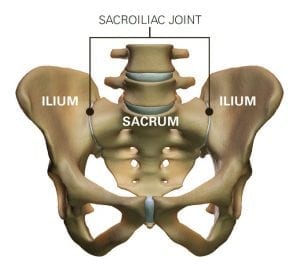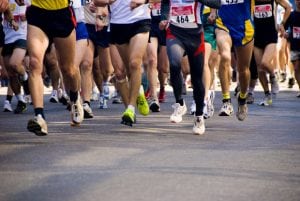Running and jogging is by far the most common general fitness activity undertaken by the UK population, and it’s also one of our favorite competitive sports. Scientific research demonstrates that Chiropractic care may enhance running performance in both recreational runners as well as professional athletes, but also plays a major role in injury prevention – weather you’re a running enthusiast, or a professional marathon runnier. Our focus at Complete chiropractic is on preventing injury before it occurs – so, how can we do that?
The problems for runners
While most of us look at running as an enjoyable activity, weather it be as part of a competitive sport or more of a leisure or fitness activity we often fail tor recognise the fact that running can, in fact, put quite a strain on the body. Some of the common issues we see in runners include…
Vertebral Subluxations
Perhaps because running is so popular, or perhaps because many of us prefer to run out in nature, we often see people with back injuries related to running. By far those most common of these conditions is the familiar mis-alignment of the vertebrae known as subluxation.
Vertebral subluxations are linked to backaches, headaches and a litany of other health concerns. Left unchecked, they can destroy an individual’s well being. Chiropractors are the only experts who focus specifically on treating subluxations – but thankfully this treatment (called chiropractic adjustment) is quick, easy and pain free!
Hip Problems
Hip problems are another common issue among runners, especially those of us who are slightly older! The sacroiliac (SI) joints are the normal source of hip pain. They connect the sacrum (the triangular bone at the base of the spine) with the pelvic bones (iliac bones) . As you might imagine, this joint plays a key role in stabilisation of the spine and the hips – If movement within the joint becomes restricted – or too loose -it can therefore result in sacroiliac joint dysfunction. Thankfully, chiropractic care has been highly successful in treating SI joint dysfunction.
For instance, in a recent case of a 32-year old male marathon runner, who ran approximately 100 to 150 kilometers per week for three years, SJ pain stopped him dead in his tracks. But just a month after completing two weeks of chiropractic care, he was pain free with the option to slowly work back into the marathon running.[1]
Tibialis Posterior Strain
Injury of the posterior tibialis muscle in the ankle is widespread among runners and joggers. This disorder is characterized by a flattening of the arch of the foot along with foot and ankle pain. Historically, this kind of issue often forced runners to give up, but today Chiropractic care can mitigate this condition in runners, according to a case report in the Journal of the Canadian Chiropractic Association.[2]
Shin Splints
Shin splints are characterized by pain along the front or either side of the lower leg are caused by inflammation of the fascia which surrounds the tibia (the leg bone connecting the ankle to the knee). Shin splints can be sparked by a wide variety of issues, but common ones for runners include, running on hard surfaces, running on tip toes, jumping-based sports and even poor choice of shoes.
Proper stretching and some disciplines such as yoga have been shown to be effective in reducing shin splints, however if shin splints are a recurring problem for you, a visit to your sports therapist might be the best course of action, since recurring shin splints are normally related to an underlying functional issue (which is exactly what we can help you resolve!) [3]
Osteoarthritis
Hip osteoarthritis often produces persistent pain that may make running more difficult, but certainly makes it less enjoyable! [4]
Fortunately, chiropractic care has an impressive track record in mediating osteoarthritis (OA) in any form. One study found that chiropractic (especially when combined with heat therapy) is a highly effective way to mitigate the effects of OA.
According to a recent report, pain reduction occurs more rapidly and to a greater degree, and range of motion increases more rapidly and to a greater degree when chiropractic and heat therapy are combined – making this an excellent treatment for runners with itchy feet! [5]
How to prevent running injury
So, now we have seen how running can lead to injury, what can you do to lower your risk ?
Regular chiropractic care is a key element since it helps correct a wide variety of problems from subluxation to postural issues. With our specialist focus on chiropractic biophysics, as well as our in house sports therapists, were better positions than most to serve the running community!
As well as chiropractic care, there’s steps you can take today to safeguard yourself…
Buy proper running shoes
Very often we see products advertised as “specialist” equipment, but in reality they’re just generic items which have been cleverly branded. This certainly isn’t the case with running shoes! Proper Running shoes are designed specifically for different foot types in order to reduce injuries. Running in the correct footwear matched for foot type and running surface is always important, but it may have a greater influence on the mechanics of running when runners become exerted.[6]
Do yourself a favor an invest in some properly fitted and well designed running shoes!
Try stretching & yoga
Like any physical activity, you should perform stretching exercises on a regular basis -as well as just prior to and following a run. Too many runners head out the door and right in to it!
When your body hasn’t been properly warmed up and stretched, your risk of injury can be as much as double what it would be with even some simple stretching.
On your next visit, ask us for some running specific stretches – there’s loads of great information online, but if you have an existing condition (or you’re prone to one!) then its best to get some tailored stretches which wont aggravate a problem.
Strengthen with resistance training
Strengthening the muscles in the front of the calf and hamstrings, to counteract tight calves and quadriceps, prevents shin splints by reducing tension exerted on the tibial bone. Strengthening core muscles allows your body to better resist falling an out of balance conditions during running – and strengthening the quads directly can help to improve your overall running distance.
Watch your posture and foot position
When running, concentrate on your posture .. The idea is to keep your centre of gravity in front of your foot strike – not behind it. By doing so you’ll improve your run, but also reduce your risk of injury. Poor gate (or running stance) is a common cause of injury – that’s one of the reasons we focus on postural analysis with our clients – correcting this can be a major factor in preventing injury! While running, also try to avoid landing on the heel or ball of your foot.
Run Better With Chiropractic
Chiropractic care can do more than just keep runners healthy however – it can also enhance the range of motion of the hip joint, which may allow runners to take longer, more efficient running steps, according to a study conducted in Sweden.
The experiment followed 17 male runners between the ages of 17 and 20. The runners were initially tested for restrictions in the hip joint, specifically for their range of hip extension. Next, they were divided into two groups. One group received chiropractic care. The other group served as a control group and received no care[7]
Results showed that the treatment group showed significantly greater hip extension ability after chiropractic treatment than did controls.
If you’re a runner, why not get in touch and book an initial consultation today?!
[1] J Manipulative Physiol Ther 2005 ;28:1-7
[2] J Can Chi ropr Assoc 2009;53:23-31
[3] Sports Med 2005;35:991-1014
[4] Sports Med 2005;35:991- 1014
[5] J Manipulative Physiol Ther 2006;29:107-114
[6] Gait Posture 2006;24
[7] J Chiropr Med 2008;7:39-47



